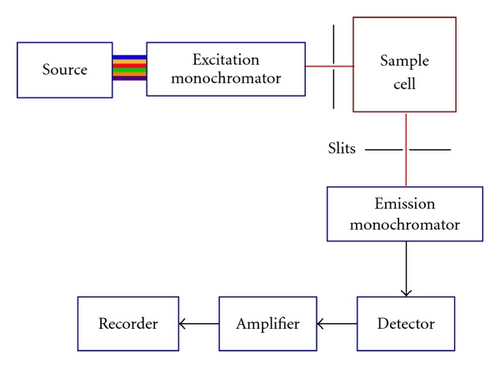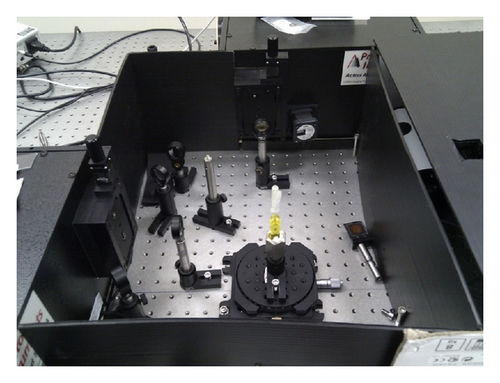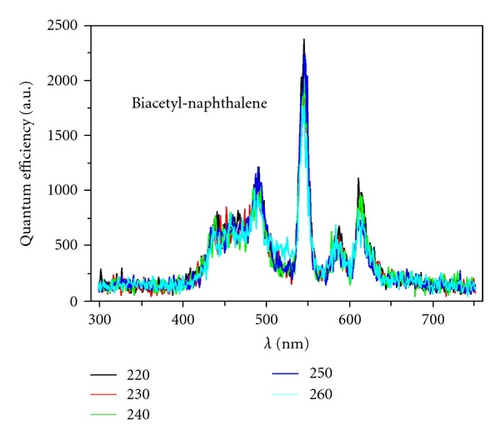Optical Energy Transfer Mechanisms: From Naphthalene to Biacetyl in Liquids and from Pyrazine to Biacetyl
Abstract
Optical energy transfer from naphthalene to biacetyl in liquids at room temperature is studied. Electronically excited naphthalene with 200–260 nm ultraviolet (UV) light emits photons in its emission band and the emitted photons are absorbed by biacetyl, which, in turn, excites biacetyl phosphorescence. The resulting phosphorescence is very stable with emission peak at 545 nm for different excitation wavelengths from 200 to 260 nm. Similar optical energy transfer is also observed from pyrazine to biacetyl. The sensitization of biacetyl by several aromatic donors has been investigated in detail. An aromatic donor, pyrazine, is raised to its first excited singlet state by absorption of ultraviolet radiation. Excitation wavelengths were selected in the first n-π* band of pyrazine. Intersystem crossing in pyrazine is sufficiently fast to give a triplet yield of almost unity as determined by the biacetyl method. The optical excess energy in the biacetyl will be released as light, which is sensitized fluorescence. Biacetyl is the simplest molecule among a wide range of α-dicarbonyl compounds, which is important for photophysics and photochemistry applications.
1. Introduction
Optical absorption in polar molecules is due to interaction with the permanent dipole moments of individual molecules. The electric field tends to align the dipoles, and the subsequent collision-induced relaxation of the oriented dipoles has a time constant in the picosecond range, giving rise to strong absorption in the far infrared. For nonpolar molecules the much smaller absorption originates in the transient dipole moments induced via collisions in the liquid.
Naphthalene, like many organic compounds, has a conjugated double-bond system, in which every other bond is a double-bond. These conjugated systems have large influence on absorption and emission spectrum of the molecule. Molar absorption coefficient of naphthalene is around 360 and the absorption spectra of naphthalene in rare gas have been extensively studied. The spectra were observed from 333 to 125 nm [1–8]. The transition energies of six transitions were assigned to π-electronic states of naphthalene. Symmetry properties of the first two excited singlet states and triplet lifetime were also reported in the context of triplet energy transfer [9–18]. Naphthalene in liquid has a different emission spectra than that of vapor phase, in which room temperature transitions are more defined.
Biacetyl, the compound 2,3-buttanedione, is the simplest molecule among a wide variety of α-dicarbonyl compounds, which has been the subject of considerable study for photophysics and photochemistry applications. The ground state of biacetyl is known to be Raman-active and IR-active in not only solid but also liquid and vapor phases. The principle absorption bands are due to n-π* electronic transitions [19, 20]. The absorption and emission spectra of the biacetyl crystal exhibit sharp vibrational structure at low temperatures [21].
Triplet-triplet energy transfer from naphthalene to biacetyl in vapor phase has been studied in [22]. In that study, decay times for different mixtures of naphthalene and biacetyl were measured under different biacetyl pressures. It was shown that the fluorescence decay time of naphthalene in cyclohexane was 96 ns [23, 24] and 130 ms lifetime for triplet state of naphthalene [22]. In this study, we concentrate on the liquid form of naphthalene and biacetyl at room temperatures as this application of the mixture is quite simple and easy to produce. It is observed that the emission spectrum of biacetyl is very stable. This may open new research directions such that incident light energy can be transferred to different wavelengths as in optical mixers and frequency down-conversion devices.
2. Material and Methods
Biacetyl and naphthalene, were of Aldrich reagent grade, used as received without any further purification, and were mixed at atmospheric pressure. The concentration of biacetyl and naphthalene was between 10−3 and 10−4 M, with the relative concentration of naphthalene/biacetyl 1⁄2 to 1⁄3 for best emission. Two Princeton Instruments Acton Advanced SP2300 model monochromators were used for all optical measurements. These devices have 600 g/mm grating with a focal length of 300 mm. The measurement setup is illustrated in Figure 1. A 500 W Xenon bulb was placed in front of the entrance slit of monochromator-1 to obtain maximum amplitude, and the entrance and exit slits were adjusted to 650 μm openings. A computer-controlled software adjusts monochromatic beams with 200–300 nm wavelength with a 10 nm step and they were emitted from the exit of monochromator-1. A quartz lens was used to focus emitted beam on the sample. The excited sample emitted beam perpendicular to the excitation beam. This emitted beam was focused on the slit of monochromator-2 with the sequential lenses. The alignment was carried out using microstage to obtain the maximum amplitude from the excited beam. The excited beam was scattered from the quartz tube and liquid interface, however the luminescence was due to the entire mixture. Since the focusing was oriented to the center of the liquid mixture, where the luminescence was dense, the excited beam did not reach and interfere with the monochromator-2. Computer-controlled scan has been performed at monochromator-2 between 300–750 nm with a step of 1 nm and 500 ms period. The emitted beam entering through the 650 μm slit from monochromator-2 was converted to electrical signals by means of the photomultiplier tube (PMT) depending on the emission amplitude. These signals were further recorded digitally in a computer through a data scan software. Dark room was used for all measurements and measurements were performed at room temperature. The emitted beam reaching the PMT was posed with 500 ms period. Because the Xenon bulb was wavelength filtered at 200–260 nm and the PMT was sensitive to the wavelength, a normalization had to be carried out. For that reason, the sample was replaced with a quartz mirror in the measurement setup and the measurement was repeated. The peaks of excitations have been obtained. The maximum amplitude obtained at 220 nm was used to calculate the normalization coefficient for each excitation wavelength. These coefficients, then were multiplied with the entire spectrum to perform the required normalization.


The setup displayed in Figure 1 was also used to study optical energy transfer from pyrazine to biacetyl. Biacetyl and pyrazine, were of Aldrich reagent grade, used as received without any further purification and were mixed at atmospheric pressure. The concentration of biacetyl and pyrazine was between 10−3 and 10−4 M, with the relative concentration of pyrazine/biacetyl 1⁄2 for the best emission.
3. Results and Discussion
The sensitization of biacetyl fluorescence by naphthalene has been investigated in detail. The emission spectrum of naphthalene-biacetyl is shown in Figure 2, where the mixture is excited from 220 to 260 nm monochromatic source. Peak emission at 545 nm is common to all excitation wavelengths. Side peaks at 491 nm and 610 nm were also observed with relative amplitudes of 0.51 and 0.47 of peak quantum efficiency, respectively. The emission spectrum of the mixture is very stable and common to all excitation wavelengths. Thus, it makes this solution an ideal candidate for photomixing applications.

An aromatic donor is excited to its first excited singlet by absorbing ultraviolet radiation. In addition, the triplet state of the donor molecules are also populated. If an acceptor molecule (i.e., biacetyl) is present, the donor (i.e., naphthalene) can transfer the electronic energy to the acceptor, in which, in turn, the acceptor molecule raises to its lowest triplet state. Excited biacetyl molecules will emit phosphorescence which will be termed as sensitized phosphorescence because the acceptor molecules do not initially absorb incident light. In this study, the donor molecule is naphthalene in liquid and the acceptor molecule is biacetyl in liquid. Hence, the phosphorescence emission of naphthalene will be absorbed by acceptor molecule biacetyl in its triplet state, then excess energy will be emitted as light at different frequencies.
- (1)
Naph + BiA + hv (200–260 nm light) → Naph* + BiA
-
Naphthalene (Naph) absorbs 200–260 nm light, but BiA does not absorb this light, hence only Naph is electronically excited and BiA is still in the ground state;
- (2)
Naph* + BiA → Naph + hv (emitted from Naph) + BiA;
- (3)
Naph + hv (emitted from Naph) + BiA → Naph + BiA*;
-
BiA* is electronically excited by absorbing the emission of Naph;
- (4)
Naph + BiA* → Naph + BiA + hv (400–650 nm emitted from BiA).
The sensitization of biacetyl fluorescence by pyrazine has been investigated in detail, in an attempt to be validated by biacetyl method. Emission spectrum of pyrazine-biacetyl is shown in Figure 3 where the mixture is excited from 305 to 325 nm monochromatic source. Peak emission at 460 nm is common to all excitation wavelengths.

- (1)
Pyz + BiA + hv (305–325 nm light) → Pyz* + BiA
-
Pyz absorbs 305–325 nm light, but BiA does not absorb this light, hence only Pyz iselectronically excited and BiA is still in the ground state;
- (2)
Pyz* + BiA → Pyz + hv (emitted from Pyz) + BiA;
- (3)
Pyz + hv (emitted from Pyz) + BiA → Pyz + BiA*;
-
BiA* is electronically excited by absorbing the emission of Pyz;
- (4)
Pyz + BiA* → Pyz + BiA + hv (450–600 nm emitted from BiA).
4. Conclusions
We show that donor molecule pyrazine emits light and biacetyl absorbs this light as an optical receiver. Similar mechanism is also observed for naphthalene and biacetyl, where donor molecule naphthalene emits light and biacetyl absorbs this light as an optical receiver. Therefore, this mechanism is called an optical antenna at the nanosecond time domain. In our study, neither excimer nor exciplex fluorescence could be recorded.




